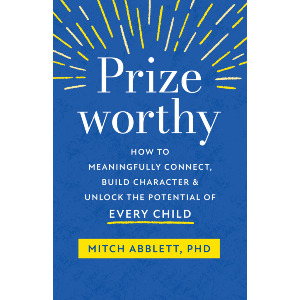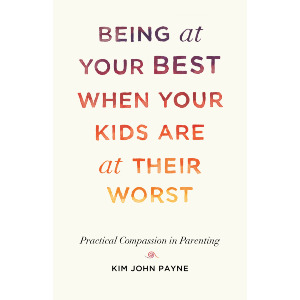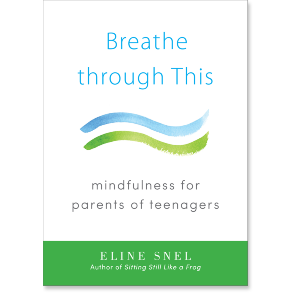An excerpt from Chapter Six of Prizeworthy by Mitch Abblett, PhD
With the children in our lives, and as hard as it may be, it is so important to shift our perspective away from trying to control them and control their daily situations and instead focus on goals we have for their lives. As attachment-wired parents, we may find it next to impossible to not assume the role of a director who makes things happen on their behalf so that they suffer less and happify more. Though we can intentionally point our children toward possibilities in the world, we cannot make them authentically engage them. We tend to get burned when we force kids toward outcomes, no matter how healthy or empowering they seem to us.
Here are three exercises to help establish a light touch for setting goals with the children in your life.
Stretching, Part 1
SNAPPing Awake
This exercise offers a method for letting go of your delusions of controlling outcome—and instead cultivating deep, mindful listening and acceptance of what is happening with your child. Trying to twist arms toward your parental agenda is the opposite of prizing. To practice mindful presence in such a moment, try “SNAPPing awake” by doing the following:
Stop what you are doing for just a moment, when you can tell you are getting edgy, reactive, or grabby with your child to just “do what they need to do.”
Notice with curiosity what is happening in your bodily senses and your thoughts.
Allow these experiences to be just as they are, without judgment or attempts to control them.
Penetrate these sensations in the body with full, deep belly breaths (slow, deep breathing that expands your belly on the inhale) and continue to breathe in this way until you notice your experience shifting.
Put your focus on this moment only, letting go of your (understandable and perhaps quite accurate) concerns for your child.
When we are triggered and flooded emotionally, it is natural for us as parents to clench and stiffen and have our reactions reflect this rigidity. If we practice “snapping awake,” we give ourselves the flexibility to be much more effective in managing tough situations. Things may just end up working out the way they need to.
Stretching, Part 2
Light-Touch Goal-Tending with Your Kids
Think of your child, and try the following as a way of practicing holding a goal for them with a light touch:
1. What is the goal? Call it specifically and vividly to mind. What is it, in your opinion as someone who cares a great deal for this cherub, they could do that (if they could really do it) would move their life forward?
2. Deeply consider this goal. I am sure it makes complete sense, and indeed would be a valuable skill or action for them to take. Write this action goal out for your child—in pen (because it matters and merits pen and not pencil!). Pause and allow the certain validity of this goal you have conjured settle and solidify in your experience.
3. Now—imagine that I, as your authorial guide, have just consulted my magic crystal ball and have seen the future for your child. In that future, he or she has not done this action. In fact, they have done pretty near the exact opposite of it! This goal is not going to happen. Go ahead and cross out the goal you have written down. (I am serious. Go ahead and cross it out!)
4. Immediately now, close your eyes and bring mindfulness to bear, as you observe your here-and-now bodily sense reactions as well as the thoughts and mental images coming up for you. Do not judge them and do not push or pull at them. How much do you find yourself wanting to control what happens for your child? Just notice this pull of very understandable desire and watch it snap and crackle inside you. It may even be such a serious, heartful goal that you are noticing some degree of emotional upset right now. Honor this pain by feeling it versus flinching from it.
Resting in this place of mindfulness of a future goal does not mean you are passive, have no role to play, and have no influence. It just means you are more likely to skillfully guide the child versus reactively trying to force what happens. Resting in the truth of the present moment’s Zero Point makes the agenda about prizing what is valuable for the child, and this makes it much more likely the child will allow, take in, and benefit from your guidance.
Remember, it is not that your goals for the child are irrelevant. You hold them lightly—on the palm of your hand, not gripped with a tight fist. Kids can sense when you have this clenching inside you, and it can lead them in the opposite direction of a worthwhile goal because they do not feel as though they are choosing, striving, and doing on their own. If you’re not gripping anything, it’s much harder for kids to play emotional tug-of-war with you, and it is much more likely they will accept your support and guidance as they learn new skills and step into the anxious gap of change.
Kids can sense when you have this clenching inside you, and it can lead them in the opposite direction of a worthwhile goal because they do not feel as though they are choosing, striving, and doing on their own.
Stretching, Part 3
Fist Full o’ Mindfulness
Now you are ready to practice both mindfulness and the Zero Point of agenda-free intention.
1. Lay your hands gently on your lap with your palms facing up.
2. Take a deep breath, and when you are ready, close your eyes and focus your attention on the sensations of either your left or your right hand.
3. Ball your hand up into a tight fist and hold it for five to ten seconds. Release your hand. Repeat this process a few times. Notice the difference between the tension and the feeling of release. Which do you prefer? Which state of your hand will be most conducive to truly teaching, leading, and guiding your child toward something that matters—the rigid fist or the flexible, open hand?
4. Now allow your hand to lie open on your lap. Notice the sensations showing up there. Do not simply “think about” your hand, but instead, feel the pulsing, the tingling, the itching—whatever might be present in the moment.
5. Continue noticing with mindfulness what shows up in your experience, whether it is a sensation in the hand, another part of your body, or even a passing thought. Notice how all these experiences come, go, and change on their own. Forcing your mind does not control the pace of change with these experiences, does it?
6. Your hand is open and can hold whatever shows up as you help to truly guide your child toward a goal that matters (to you, and ideally to them as well). The uncomfortable pangs and the gold-medal promise of a given moment simply arise and, with presence, you can hold it all gently. You are not passive. With grace you can help kids notice openings for taking skillful, healthy action.
Kids do not reach out to accept fists from adults. They will, with patience, reach toward open, outstretched hands.
Share
Related Books
$17.95 - Paperback
Being at Your Best When Your Kids Are at Their Worst
$16.95 - Paperback
$15.95 - Paperback
$19.95 - Paperback







